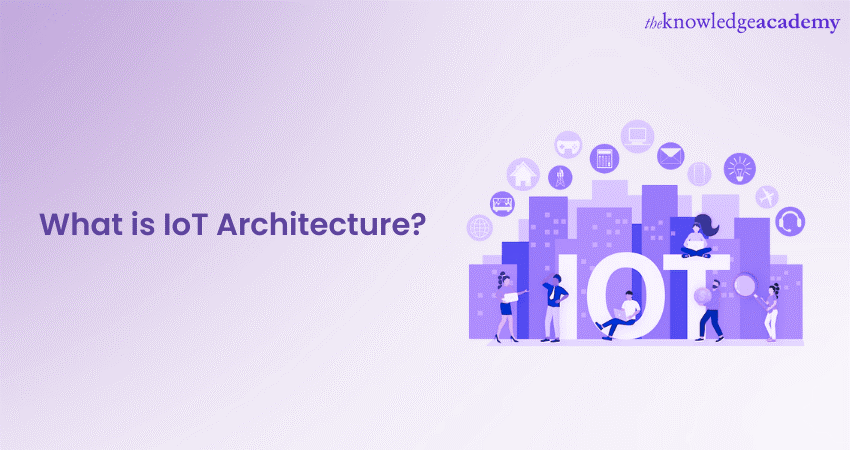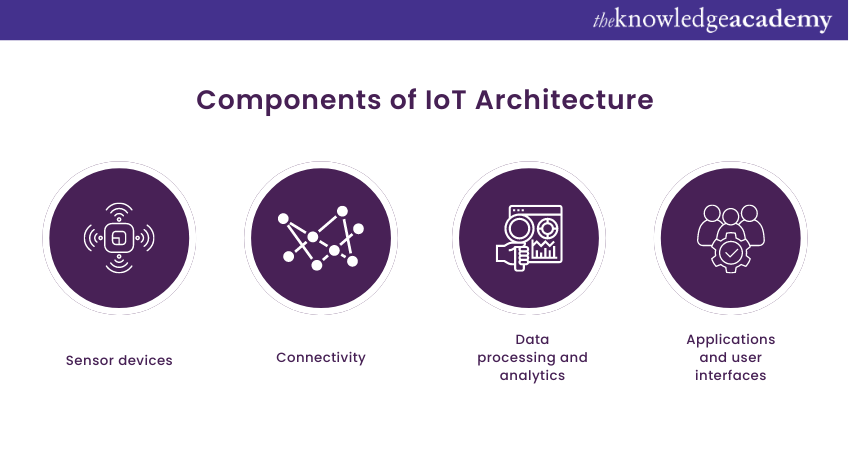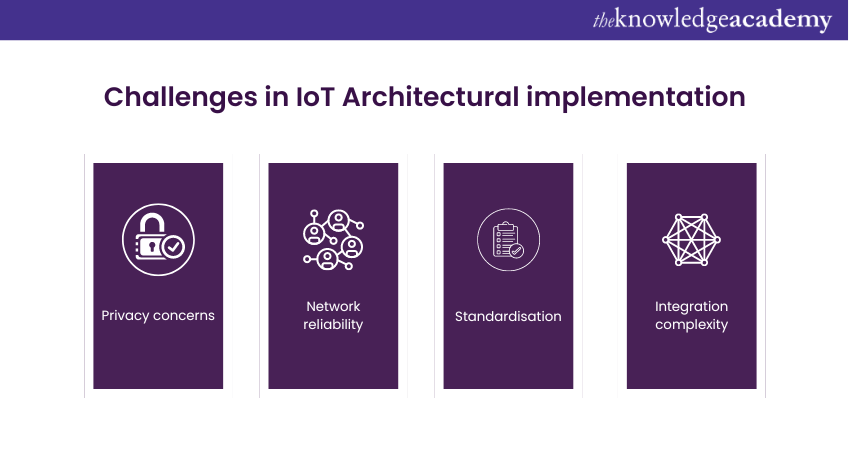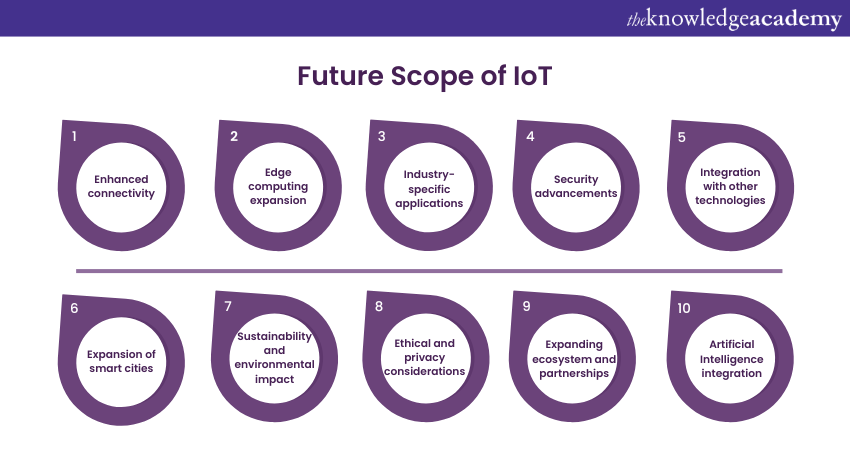We may not have the course you’re looking for. If you enquire or give us a call on 01344203999 and speak to our training experts, we may still be able to help with your training requirements.
Training Outcomes Within Your Budget!
We ensure quality, budget-alignment, and timely delivery by our expert instructors.

Imagine a world where your coffee machine talks to your alarm clock, your car communicates with traffic lights, and your refrigerator orders groceries when you're running low. This isn't science fiction—it's the reality made possible by the Internet of Things (IoT). At the heart of this interconnected universe is IoT Architecture, the structural backbone that enables devices, systems, and services to communicate seamlessly.
IoT Architecture is crucial for ensuring that data flows smoothly from sensors to servers and ultimately to the end users who benefit from actionable insights. With IoT devices expected to skyrocket to over 29 billion by 2030 as per Statista. So, understanding this architecture is more important than ever.
In this blog, we'll unravel the layers of IoT Architecture, from the perception layer to the application layer, and explore real-world examples. We will also learn about implementation challenges, and future trends in IoT technology.
Table of Contents
1) Understanding IoT Architecture
2) Components of IoT Architecture
3) Types of IoT Architectures
4) Examples of IoT Architecture
5) Challenges in IoT Architectural implementation
6) Future scope of IoT
7) Choosing the right IoT platform
8) Conclusion
Understanding IoT Architecture
Learning IoT Architecture is key to comprehending the complexities of Internet of Things (IoT) networks. The network structure defines not only the structures but also the communication flow among the connected devices, sensors, networks, and apps in the smart ecosystem.
Moreover, the ecosystem arranges sensors, connectivity, data processing, and user interfaces. The IoT Architecture allows for straightforward data capture, transfer, and analysis, making it possible to make intelligent decisions and gain valuable insights.
Individuals can comprehend the different layers and components of IoT Architecture to design, deploy, and optimise IoT systems effectively. The structure lays the foundation for the successful implementation of IoT solutions across various industries.

Components of IoT Architecture
IoT Architecture comprises various components, including sensor devices that collect data from the physical environment, connectivity technologies that enable seamless communication, data processing and analytics for extracting insights, and applications and User Interfaces(UI) for interacting with the IoT system.
These components work collaboratively to create a robust and functional IoT ecosystem, facilitating data collection, transmission, analysis, and user engagement. Here is a brief list of the components discussed further:

1) Sensor devices: Sensor devices hold a pivotal position in the IoT Architecture by capturing instantaneous information from the physical environment. They consist of different types of sensors, such as temperature, motion, and humidity sensors.
2) Connectivity: The connectivity of IoT devices is achieved by wireless communication technologies such as Wi-Fi, Bluetooth, Zigbee, and cellular networks. They allow the exchange of information and create a stable connection as a component of the IoT environment.
3) Data processing and analytics: Data processing and analytics imply analysing collected data to draw important conclusions and make reasonable decisions. This component comprises data filtering, aggregation, Machine Learning algorithms, and statistical analysis.
4) Applications and user interfaces: IoT systems can be accessed via applications and User Interfaces. These offer a user-friendly interface where users can view and adjust connected device settings, collect data insights, and customise system settings to match their preferences.
Learn about networks of embedded objects, by signing up for the Introduction To AWS IoT Course now!
Types of IoT Architectures
The types of IoT Architectures include centraised, decentralised, and hybrid IoT. Each has its own characteristics and deployment strategies, offering flexibility and scalability in designing IoT systems based on specific requirements and use cases.
Here are the three major types discussed in further detail:
1) Centralised IoT Architecture: In the centralised IoT Architecture, all the data processing, analysis, and decision-making operations are carried out on a centralised server or cloud platform. The sensors and connected devices send data to the main hub, responsible for processing and analysing the data.
It provides design simplicity, central control, and easy management. Nevertheless, it will have the problems of scalability and latency, whereby all the data traffic will pass through a single point.
2) Decentralised IoT Architecture: In an IoT Decentralised Architecture, the data processing and decision-making functions are distributed across many edge devices or gateways. Each device or gateway can process the data on a local level, thus decreasing the number of interactions with a central server.
3) Hybrid IoT Architecture: A hybrid IoT Architecture combines elements of both centralised and decentralised structures. It leverages the strengths of each approach to create a flexible and robust system. Certain data processing tasks in this network may be performed centrally, while others are distributed to edge devices or gateways.
It balances scalability, real-time processing, and efficient data management. Hybrid structures often deploy in large-scale IoT deployments requiring central control and localised processing capabilities.
Examples of IoT Architecture
Here is a list of three examples of IoT Architecture discussed briefly:
1) Smart home automation: Smart home automation is a stack of IOT that helps users remotely control and check the many parts of their homes. It consists of linking elements like lights, thermostats, security devices, and appliances to a central hub, allowing for remote management through an app or voice control.
2) Industrial IoT: Industrial IoT (IIoT) uses IoT Architecture in industrial environments. It brings the interconnection of devices, machines, and sensors to a network, allowing data collection, real-time monitoring, predictive maintenance, and the optimisation of industrial processes. IIoT increases productivity, safety, and efficiency in the manufacturing, logistics, energy, and agriculture sectors.
3) Smart cities: Smart cities use IoT Architecture to improve citizens' lives and manage urban activities. They do this by combining different Internet of Things devices, sensors, and systems to control the city's infrastructure, including transportation, utilities, waste management, and public security. Using data intelligence and automation, smart cities seek to increase sustainability, resource efficiency, and citizens' welfare.
Acquire knowledge of sensor fusion for embedded IoT networks, by signing up for the Sensor and Data Fusion Training Course now!
Challenges in IoT Architectural implementation
Here are the challenges of the implementations in IoT discussed:

1) Privacy concerns: Privacy concerns in IoT Architecture revolve around collecting, storing, and using personal data. As IoT systems gather vast amounts of data, ensuring data privacy and protecting sensitive information becomes crucial. Addressing privacy concerns involves implementing robust security measures, data encryption, and user consent mechanisms to maintain trust and comply with privacy regulations.
2) Network reliability: Network reliability is vital for seamless communication and data transmission in IoT Architecture. With numerous devices and sensors connected, network disruptions or failures can hinder the functioning of the entire system. Ensuring network reliability involves deploying redundant networks, robust connectivity technologies, and monitoring mechanisms to maintain consistent and uninterrupted connectivity.
3) Standardisation: Standardisation plays a key role in IoT Architecture, enabling interoperability and compatibility among different devices and systems. Establishing common standards and protocols ensures that devices from different manufacturers can communicate and work together seamlessly. Standardisation efforts aim to enhance system integration, scalability, and the ability to leverage diverse IoT solutions.
4) Integration complexity: Integration complexity refers to the challenges associated with connecting and integrating diverse devices, protocols, and systems within an IoT Architecture. Different devices may use different communication protocols and data formats, making it complex to ensure interoperability. Addressing integration complexity requires careful planning, protocol translation, data mapping, and leveraging middleware platforms to facilitate smooth data flow and system integration.
Acquire in-depth knowledge of Artificial Intelligence, by signing up for the Introduction to Artificial Intelligence Course now!
Future Scope of IoT
The future of IoT holds many possibilities for individuals, as well as public and private sector enterprises. Here is a list of the possibilities:

1) Enhanced connectivity: With the rising trend of advanced connectivity and the appearance of newer technologies like 5G and satellite communication, smoothness and real-time data transmission are possible, which enables a wide range of IoT applications.
2) Edge computing expansion: Edge computing will be essential in the development of IoT as it allows data processing to occur near the origin, thereby reducing latency and raising reaction times.
3) Industry-specific applications: IoT will continue to change different industries, such as healthcare, agriculture, transportation, and energy.
4) Security advancements: As IoT adoption expands, security measures will become more sophisticated to address emerging threats.
5) Integration with other technologies: IoT will increasingly integrate with other transformative technologies, such as Blockchain, Virtual Reality, and Augmented Reality.
6) Expansion of smart cities: The idea of smart cities will become more prevalent, with IoT acting as a key conductor for managing and improving urban systems.
7) Sustainability and environmental impact: IoT will promote sustainability through efficient resource management, monitoring environmental conditions and energy optimisation.
8) Ethical and privacy considerations: As IoT advances, ethical and privacy concerns will gain more attention.
9) Expanding ecosystem and partnerships: The growth of IoT will continue to unfold with partnering diverse participants such as manufacturers of devices, network providers, software developers, and industry-specific solution providers.
10) Artificial Intelligence integration: The IoT systems will progressively combine AI capabilities, allowing intelligent data processing, forecasting and automation.
Choosing the right IoT platform
Selecting the Ideal IoT platform Identifying the appropriate IoT platform for a project hinges on key factors such as scalability, compatibility, and user-friendliness. Amidst a plethora of options, discerning the optimal choice can be daunting. A clear understanding of these elements is crucial for a successful implementation. Let’s explore some prevalent platforms and the considerations necessary for an informed decision to fulfil your requirements.
Renowned IoT platforms
In the quest for a suitable IoT platform for a project, several critical aspects must be considered. Renowned platforms like Microsoft Azure IoT, AWS IoT Core, PTC ThingWorx, and Google Cloud Platform offer services, including device management, data storage, and processing capabilities tailored to diverse industries. IBM Watson stands out for its analytics and Machine Learning tools. Assessing these offerings in light of the communication protocols they support is vital for seamless integration with current applications or frameworks.
These prominent solutions allow users to select a cloud-based service that aligns with their unique needs – scalability for extensive datasets, security updates, or cost considerations about data distribution within any enterprise architecture.
The evaluation process must also weigh access methods against budgetary goals to ensure the chosen criteria encompass all relevant factors, from data centre integration to the balance between power consumption and reliability, especially before advancing towards internet-connected machines driven by Machine Learning algorithms.
Key considerations
When choosing an IoT platform, its data storage and processing capacity is paramount. The platform must efficiently manage substantial data volumes and adapt to varying demands. Investigating communication protocols such as Bluetooth, Wi-Fi, or cellular networks is essential for establishing a robust connection among devices that transmit and collate data wirelessly.
Integration with preexisting systems and applications is another crucial aspect when selecting an IoT platform. This facilitates a seamless transition and the incorporation of new features during the development phase. A thorough evaluation of these factors ensures the selection of a custom-fit platform to meet all the project’s requirements within your organisation.
Conclusion
IoT Architecture is a fundamental framework that facilitates the functionality and connectivity of the Internet of Things. The entire concept is composed of multiple elements and forms, along with many options that influence the development and deployment of IoT applications.
As IoT continues to develop, it opens up more possibilities for connected devices, automated machines, and data-driven decision-making, creating conditions for a bright future with IoT technologies for industries, cities, and homes.
Acquire a fundamental understanding of IoT concepts, by signing up for the Internet of Things IoT Systems and Applications Training now!
Frequently Asked Questions

Privacy Concerns are addressed in IoT Architecture through multi-layered security processes. These processes involve encryption, access controls, and secure communication protocols to protect data against unauthorised access and breaches. Regular updates and security, as well as update patches, minimise risks.

Cloud Computing is the main component of IoT. In addition to providing scalable storage and speedy processing for the huge data generated from IoT devices, it facilitates real-time data analysis, remote device management, and the incorporation of IoT applications.

The Knowledge Academy takes global learning to new heights, offering over 30,000 online courses across 490+ locations in 220 countries. This expansive reach ensures accessibility and convenience for learners worldwide.
Alongside our diverse Online Course Catalogue, encompassing 17 major categories, we go the extra mile by providing a plethora of free educational Online Resources like News updates, Blogs, videos, webinars, and interview questions. Tailoring learning experiences further, professionals can maximise value with customisable Course Bundles of TKA.

The Knowledge Academy’s Knowledge Pass, a prepaid voucher, adds another layer of flexibility, allowing course bookings over a 12-month period. Join us on a journey where education knows no bounds.

The Knowledge Academy offers various Advanced Technology Courses, including the Internet of Things IoT Systems and Applications Training. These courses cater to different skill levels, providing comprehensive insights into IoT Devices.
Our Advanced Technology Blogs cover a range of topics related to the Internet of Things, offering valuable resources, best practices, and industry insights. Whether you are a beginner or looking to advance your Internet of Things skills, The Knowledge Academy's diverse courses and informative blogs have got you covered.
Upcoming Data, Analytics & AI Resources Batches & Dates
Date
 Internet of Things IoT Systems and Applications Training
Internet of Things IoT Systems and Applications Training
Thu 23rd Jan 2025
Thu 20th Mar 2025
Thu 22nd May 2025
Thu 17th Jul 2025
Thu 18th Sep 2025
Thu 20th Nov 2025







 Top Rated Course
Top Rated Course


 If you wish to make any changes to your course, please
If you wish to make any changes to your course, please


